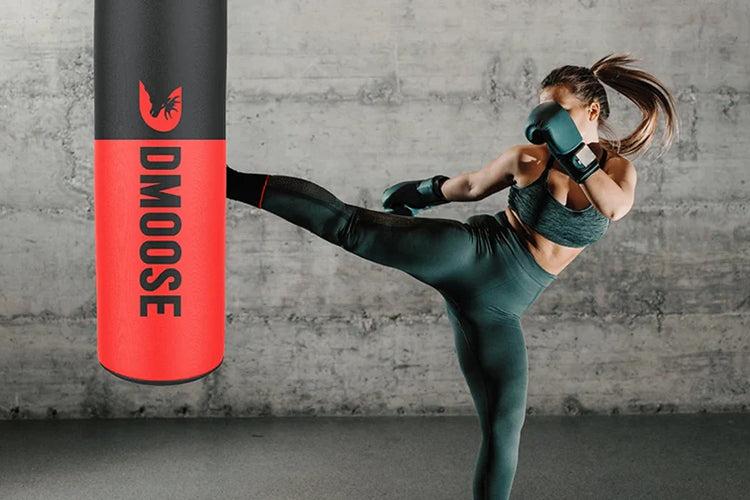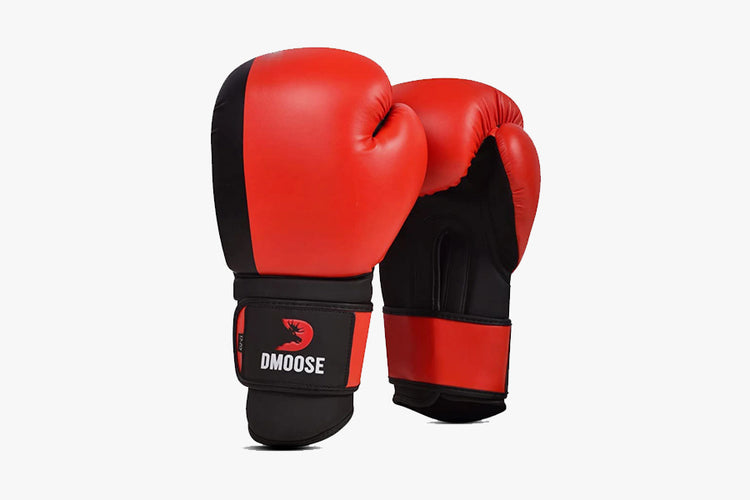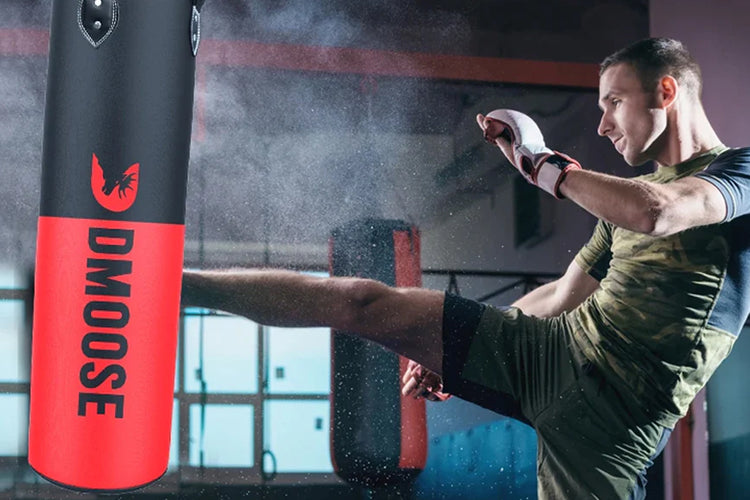Treadmills and stationary bikes are tedious and time-consuming. If you want a fun workout that benefits your health, try boxing or martial arts training! These activities allow you to tap into your primal instincts, so you can let loose while also getting in shape. In addition to providing fun, bag training offers some functional advantages that more popular forms of cardio lack.
The cadence is always consistent when you're on a treadmill, bike, or rowing machine, and your breathing falls into a rhythm. However, training with a heavy punching bag forces you to breathe rapidly and erratically, like in an actual fight. Punching bag workouts are so powerful that if your striking technique is good, the power generated will start from your feet and be released through the twist of your torso.
No other training tool can work your whole body like punching bag workouts can. You move in multiple dimensions, using muscles you wouldn't usually use. This article is all about the wonders of punching bag workouts and how they are perfect for those who get bored with aerobics or weightlifting. You'll also discover three workouts to help you trim and condition your body for strength and stability.
Choosing Between a Heavy Bag and a Punching Bag

If you aren't a fitness pro and have never had exposure to any combat sport, especially boxing, you'll think they are the same. Don't worry about it because while most people use these terms interchangeably, we will explain the difference to you.
Heavy Bag
A regularheavy bag is typically four or five feet long and weighs between 30 and 200 pounds. It's mainly used for punching, hanging from the ceiling, or another overhead structure. The heavy bag doesn't move much when one strikes it (that's because it's heavy).
The classic heavy bag is cylindrical, but newer versions of these bags differ in shape, size, and effects. Heavy bags with contours in the market simulate human body curves and give you the sense of being in an actual fight.
Punching Bags
Punching bags are made from leather, canvas, or any other sturdy and lasting material that will only wear down slowly. They can be filled with sand, water, textile, or anything that adds to the bag's weight.
Punching bags are not just hung from ceilings or overhead structures; they can be attached to a base on floors or left alone to roll freely on the floor, like a free-standing punching bag, further enhancing the challenge involved in a workout.
These bags are unstable, meaning they can move and wobble on the floor when you hit them. You'll need a lot of footwork to box with a bag that's not stable, and it's usually challenging for new boxers who have not yet achieved the rhythm and coordination to be comfortable with extra challenges.
Then there are speed bags, yet another type of punching bag. Speed bags are small, teardrop-shaped, and ceiling-mounted. You might have seen them in Rocky movies or other videos of old-time boxers training.
Speed bags improve reaction time and hand-eye coordination while simultaneously developing punching speed. Still, they aren't meant to be hit hard. Using a speed bag, you employ different striking techniques than throwing power punches.
Equipment Required for Punching Bag Workout
Punching bag workouts are just right to get a full-body workout and improve your boxing skills. However, there is some fitness equipment that you will need to have a successful workout.
Inner Gloves
First, you will need inner gloves for a comfortable fit. Your boxing gloves aren't going to fit your bare hands. You'll be sweaty, and the boxing gloves slip throughout the workout. This will not only be uncomfortable but also affect your performance adversely. So the inner boxing gloves or straps are worn to prevent sweating and allow a comfortable, snug fit of the gloves on the hands.
Boxing Gloves

Second, you will need boxing gloves to prevent injury. You can hurt your hands pretty bad while working on punching bags with your bare hands. To prevent tears and injuries, boxing gloves and MMA gloves are used. They enhance performance by protecting your hands.
Heavy Bag

Third, you will need a heavy bag to practice your punches. Most definitely, you are not supposed to be punching against walls. A suitable punching bag is essential. With the right fitness equipment, you can have a great workout and improve your boxing skills simultaneously.
Related Article: Inner Boxing Gloves - Gym Bag Essentials to Get the Perfect Sport Experience
Benefits of Punching Bag Workout
Although it is often assumed that only professional boxers or people addicted to boxing benefit from punching bags, this isn't the case, even beginners reap many fitness benefits from a punching bag during their workout routine. While many think that the sole purpose of using a punching bag is only to strengthen arm muscles, there are numerous benefits which include:
Full-Body Workout
Punching bag workouts engage multiple muscle groups simultaneously, providing a comprehensive full-body workout. The repetitive punching and kicking motions work your arms, shoulders, chest, back, core, and legs, promoting overall strength and muscle development.
Cardiovascular Fitness
Punching bag workouts are high-intensity exercises that elevate your heart rate, leading to improved cardiovascular endurance. Incorporating these workouts into your routine can enhance your stamina, boost lung capacity, and increase your overall aerobic fitness.
Stress Relief
Hitting a punching bag can serve as a powerful stress-relieving activity. It allows you to release pent-up energy, frustration, and stress in a controlled and productive manner. The rhythmic motion and intensity of the workout can also trigger the release of endorphins, promoting feelings of relaxation and well-being.
Improved Coordination and Balance
Punching bag workouts require precise movements and coordination between your upper and lower body. The constant footwork, striking combinations, and defensive maneuvers help improve your overall coordination, agility, and balance.
Core Strength and Stability
Punching bag workouts engage your core muscles to maintain balance, generate power, and transfer force from your lower body to your upper body. Regularly training with a punching bag can strengthen your abs, obliques, and lower back muscles, enhancing core stability and overall functional strength.
Increased Power and Speed
You'll gradually develop increased punching power and impressive speed as you practice punching bag workouts. The resistance provided by the bag challenges your muscles to generate force, promoting muscular strength development and explosive power.
Self-Defense Skills
Punching bag workouts can be an effective way to develop fundamental self-defense skills. By practicing proper punching and kicking techniques, footwork, and defensive maneuvers, you can improve your ability to defend yourself in real-life situations.
Mental Focus and Discipline
Engaging in punching bag workouts requires concentration, focus, and discipline. The repetitive nature of the exercises demands mental resilience, allowing you to push through fatigue and maintain proper form. Over time, this can translate into improved mental focus, discipline, and perseverance in other aspects of life.
Weight Management and Calorie Burn
Punching bag workouts are intense and physically demanding, making them excellent calorie-burning exercises. Cardio and strength training in these workouts can help you shed excess weight, increase your metabolic rate, and improve body composition.
Increased Confidence and Self-Esteem
Regularly participating in punching bag workouts can boost your confidence and self-esteem. As you progress and see improvements in your technique, strength, and fitness level, you'll develop a sense of accomplishment and a belief in your own abilities. This newfound confidence can extend to other areas of your life, enhancing your overall well-being.
20 Minutes Punching Bag Workout for Beginners

This 20-minute punching bag workout is perfect for beginners who are new to the sport and need a workout that is slow and gradual. However, these 20 minutes help build your body and stamina for longer, more challenging workouts in no time.
Workout:
- Warmup: 5-to-10-minutes
- Jab, cross, and squat: 45 seconds work, 15 seconds rest
- Cross punches (dominant side): 45 seconds work, 15 seconds rest
- Cross punches (non-dominant side): 45 seconds work, 15 seconds rest
- Side kick-punch combo: 90 seconds work, 30 seconds of rest
- Lunge, kick, jab, cross: 45 seconds work, 15 seconds rest
- Hooks (dominant side): 45 seconds work, 15 seconds rest
- Hooks (non-dominant): 45 seconds work, 15 seconds rest
- Burpee with push up, straight punches, and hooks: 45 seconds work, 15 seconds rest
30 Minutes Endurance Punching Bag Workout
This 30-minute workout will help build stamina by refining your boxing technique and improving your fitness levels. All rounds after the warmup are two minutes each.
Warmup (5 minutes)
Alternate between jumping rope and high knees for 2 minutes each. Next, complete two rounds of the following:
Round 1: Cycles of
- 10 cross punches (dominant side)
- 10 cross punches (non-dominant side)
- Round 2: Dominant side cycles of
- Lunge
- Jab and kick
- Jab, jab, power punch
- Round 3: Non-dominant side cycles of
- Lunge
- Jab and kick
- Jab, jab, power punch
Round 4: Cycles of
- 10 burpees
- Right uppercut, jab, jab, hook, cross
- Bob and weave
- Left uppercut, jab, jab, hook, cross
Round 5: Cycles of
- 10 reps of right side kick
- 30 straight punches
- 10 reps of left side-kicks
- 30 straight punches
Round 6: All-out alternating power punches
- Cooldown stretch.
20 Minutes HIIT Punching Bag Workout
This 20-minute metabolic-conditioning-based workout will torch some serious calories and get your heart pounding in no time. You'll perform each exercise for 30 seconds before resting for the next 10 seconds. After rest, you'll move on to the next exercise. You'll need to complete five rounds of the circuit.
- Warmup: 2 minutes of jumping rope.
- Round 1: Straight, powerful punches using a right-left-left-right combo.
- Round 2: Burpees
- Round 3: Cycles of one right kick, one left kick, three right kicks, and three left kicks.
- Round 4: High knees sprinting
- Round 5: Cycles of:
- Jab, cross
- Uppercut
- Cross, hook
- Uppercut
- Hook, cross
- Uppercut
- Round 6: Push-ups with alternate shoulder taps
- Cooldown stretch.
Related Article: 14 Weeks Full Body HIIT Calorie Destroyer Workout & Meal Plan
FAQs
1. How long should you work out with a punching bag?
Depending on how fit you are and how hard you want to push yourself, a beginner's punching bag workout could last anywhere from 15 minutes to half an hour. If this is your first time boxing, taking things slowly during a more extended session might be best.
2. How hard should you hit a heavy bag?
A general guide for those inexperienced is to start around 50-70% of your maximum power when punching a heavy bag. This will allow you more time to focus on proper form rather than tiring yourself out. As you become more comfortable and skilled, harder punches with greater force behind them won't lead to as many injuries, so gradually increase your punching power.
3. Do only boxers use punching bag workouts for conditioning and toning?
Not necessarily. Anyone can try a punching bag workout if they have the required equipment and are interested in learning the techniques.
4. What are some of the tips for a punching bag workout?
- To safeguard your knuckles, make sure to wrap your hands correctly.
- Warm up and cool down before and after every workout routine.
- To enhance your footwork, move around the bag while practicing each drill instead of staying in one place.
- Concentrate on form, speed, and accuracy when hitting the punching bag.
- Breathe steadily throughout-- remember to exhale!
Key Takeaways
Incorporating punching bag workouts into your fitness routine can significantly impact your arms and core strength.
These workouts provide an excellent outlet for stress and tension and engage multiple muscle groups, promoting improved coordination, endurance, and power. Regularly practicing punching bag exercises can achieve a sculpted upper body and a rock-solid core while boosting your overall fitness level.
So grab those gloves, step up to the bag, and get ready to experience an exhilarating workout that will ignite your arms and core like never before. Get ready to unleash your inner fighter and reap the incredible benefits of punching bag training.








